西方文化第一次作业90分
- 格式:doc
- 大小:87.50 KB
- 文档页数:9
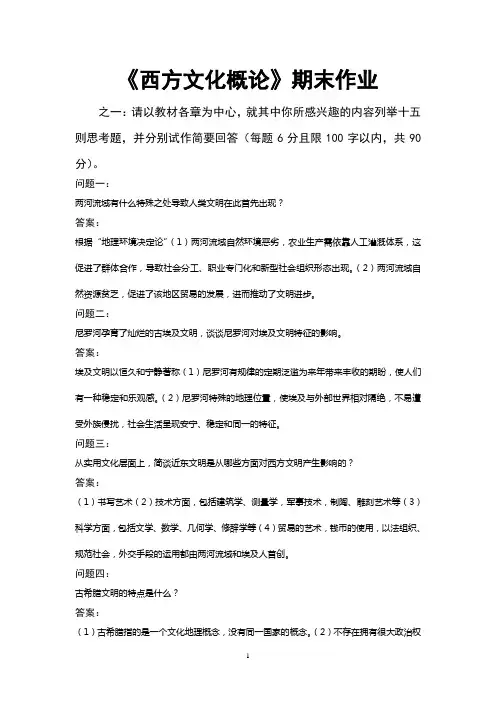
《西方文化概论》期末作业之一:请以教材各章为中心,就其中你所感兴趣的内容列举十五则思考题,并分别试作简要回答(每题6分且限100字以内,共90分)。
问题一:两河流域有什么特殊之处导致人类文明在此首先出现?答案:根据“地理环境决定论”(1)两河流域自然环境恶劣,农业生产需依靠人工灌溉体系,这促进了群体合作,导致社会分工、职业专门化和新型社会组织形态出现。
(2)两河流域自然资源贫乏,促进了该地区贸易的发展,进而推动了文明进步。
问题二:尼罗河孕育了灿烂的古埃及文明,谈谈尼罗河对埃及文明特征的影响。
答案:埃及文明以恒久和宁静著称(1)尼罗河有规律的定期泛滥为来年带来丰收的期盼,使人们有一种稳定和乐观感。
(2)尼罗河特殊的地理位置,使埃及与外部世界相对隔绝,不易遭受外族侵扰,社会生活呈现安宁、稳定和同一的特征。
问题三:从实用文化层面上,简谈近东文明是从哪些方面对西方文明产生影响的?答案:(1)书写艺术(2)技术方面,包括建筑学、测量学,军事技术,制陶、雕刻艺术等(3)科学方面,包括文学、数学、几何学、修辞学等(4)贸易的艺术,钱币的使用,以法组织、规范社会,外交手段的运用都由两河流域和埃及人首创。
问题四:古希腊文明的特点是什么?答案:(1)古希腊指的是一个文化地理概念,没有同一国家的概念。
(2)不存在拥有很大政治权利和干预世俗生活的宗教力量。
(3)关注人类自身问题,对人本主义和理性精神的不懈追求是希腊文化的根本特征。
问题五:雅典是如何成为希腊地区一大强盛城邦的?答案:雅典被视为希腊民主制的典范,其新形式的政体有两个鲜明特征:任期限制和责任制,将权力与责任联系起来。
雅典所推行的一系列带有首创性的政治改革使其摆脱了长期内政的困扰,经济实力和政治影响均得到加强。
问题六:戏剧被誉为古希腊文学的最高成就,简述你对希腊戏剧的认识。
答案:希腊戏剧以一种舞台表演艺术形式出现,包括悲剧和喜剧。
悲剧主要表现的是主人公的英雄行为,其形象高大雄伟,气势壮烈磅礴,具有永恒的艺术魅力和道德教化作用。
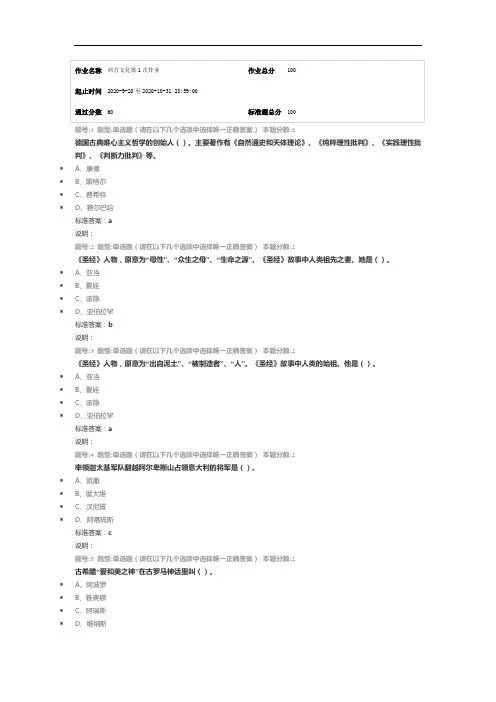
标准答案:d说明:题号:6 题型:判断题本题分数:3文艺复兴在字面上是指“古希腊罗马文化的复兴”,而实质上是欧洲社会转型期(15-17世纪)发生的一次重大的思想文化运动。
在“复兴”古希腊罗马文化的旗帜下,文艺复兴运动运用“人文主义”的思想武器对当时的封建主义和宗教神学思想进行了批判,为欧洲进入现代工业社会奠定了文化思想的基础。
•1、错•2、对标准答案:2说明:题号:7 题型:判断题本题分数:3北美殖民地时期的文学是在印第安人文学的基础上发展起来的。
虽然这时期没有产生较高水平的文学作品,但也出现了具有清教主义特色,或带有类似圣经风格、或宣传人道主义思想的文学作品。
•1、错•2、对标准答案:1说明:题号:8 题型:判断题本题分数:319世纪五六十年代.英国的现实主义正处于巅峰状态,文坛上就响起了与之迥然相异的另类声音。
“为艺术而艺术”,还是“为现实而艺术”,人们为艺术的发展竖起了截然相反的方向标。
•1、错•2、对标准答案:2说明:题号:9 题型:判断题本题分数:32100 BC 以后移居在意大利半岛中部拉丁姆平原上的拉丁部落人创立了拉丁文化,他们后来接受了希腊文化,并在753 BC 建立了罗马城,是一个实行军事民主的农业社会。
•1、错•2、对标准答案:2说明:题号:10 题型:判断题本题分数:3莫里哀(1622-1673)是英国最杰出的喜剧家之一。
他是古典主义作家,但并不拘泥于古典主义法则。
他的喜剧具有鲜明的反封建、反教会的特色,但也带有宫廷色彩。
•1、错•2、对标准答案:1说明:题号:11 题型:判断题本题分数:3荷马时代正是希腊神话的形成时期,古希腊人信奉多神教,赫西俄德曾创作了一部神的史诗——《神谱》,主要描写“奥林匹斯神系”,前后两辈。
•1、错•2、对标准答案:1说明:题号:12 题型:判断题本题分数:3苏格拉底是开创希腊哲学研究新方向的划时代的思想家,他把研究对象从自然转向了社会和人类的内心世界,专门探讨人类的心灵智慧与活动能力.•1、错•2、对标准答案:2说明:题号:13 题型:判断题本题分数:3在公元313年君士坦丁颁布“米兰赦令”,宣布给基督教以合法地位。
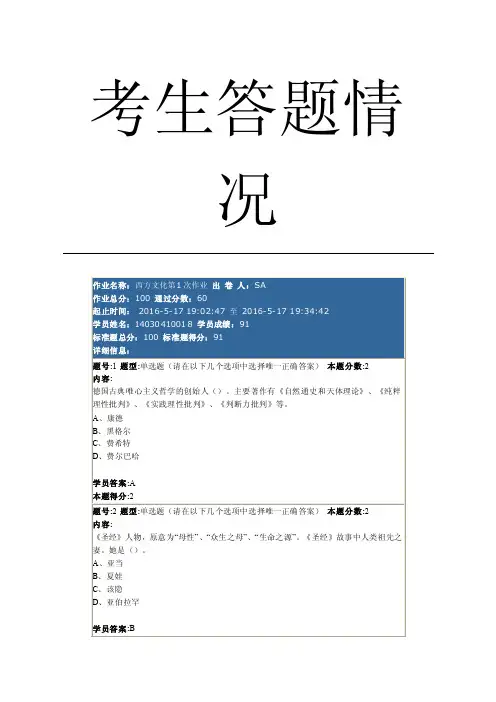
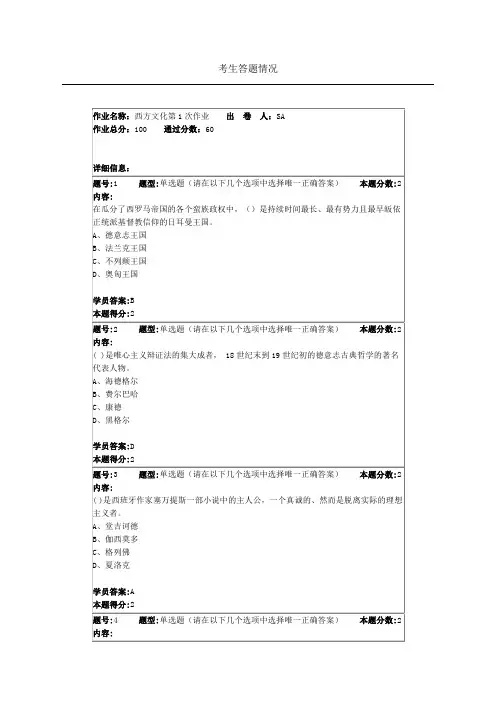
考生答题情况作业名称:西方文化第1次作业出卷人:SA作业总分:100 通过分数:60详细信息:题号:1 题型:单选题(请在以下几个选项中选择唯一正确答案)本题分数:2内容:在瓜分了西罗马帝国的各个蛮族政权中,()是持续时间最长、最有势力且最早皈依正统派基督教信仰的日耳曼王国。
A、德意志王国B、法兰克王国C、不列颠王国D、奥匈王国学员答案:B本题得分:2题号:2 题型:单选题(请在以下几个选项中选择唯一正确答案)本题分数:2内容:( )是唯心主义辩证法的集大成者, 18世纪末到19世纪初的德意志古典哲学的著名代表人物。
A、海德格尔B、费尔巴哈C、康德D、黑格尔学员答案:D本题得分:2题号:3 题型:单选题(请在以下几个选项中选择唯一正确答案)本题分数:2内容:( )是西班牙作家塞万提斯一部小说中的主人公,一个真诚的、然而是脱离实际的理想主义者。
A、堂吉诃德B、伽西莫多C、格列佛D、夏洛克学员答案:A本题得分:2题号:4 题型:单选题(请在以下几个选项中选择唯一正确答案)本题分数:2内容:公元313年,罗马皇帝()颁布了《米兰敕令》,标志着基督教在罗马帝国中取得了合法地位。
A、凯撒B、屋大维C、汉尼拔D、君士坦丁学员答案:D本题得分:2题号:5 题型:单选题(请在以下几个选项中选择唯一正确答案)本题分数:2内容:在古希腊历史上,第一次用哲学语言代替神话语言来说明万物的本原的哲学学派是()。
A、米诺斯学派B、米利都学派C、希腊学派D、经院学派学员答案:B本题得分:2题号:6 题型:单选题(请在以下几个选项中选择唯一正确答案)本题分数:2内容:古罗马共和国的最后一任执政官和第一位皇帝是()。
A、凯撒B、屋大维C、汉尼拔D、君士坦丁学员答案:B本题得分:2题号:7 题型:单选题(请在以下几个选项中选择唯一正确答案)本题分数:2内容:马其顿亚历山大大帝是古希腊著名哲学家()的弟子。
A、苏格拉底B、巴门尼德C、希罗多德D、亚里士多德学员答案:D本题得分:2题号:8 题型:单选题(请在以下几个选项中选择唯一正确答案)本题分数:2内容:十三世纪最杰出的经院哲学家和神学家是()。
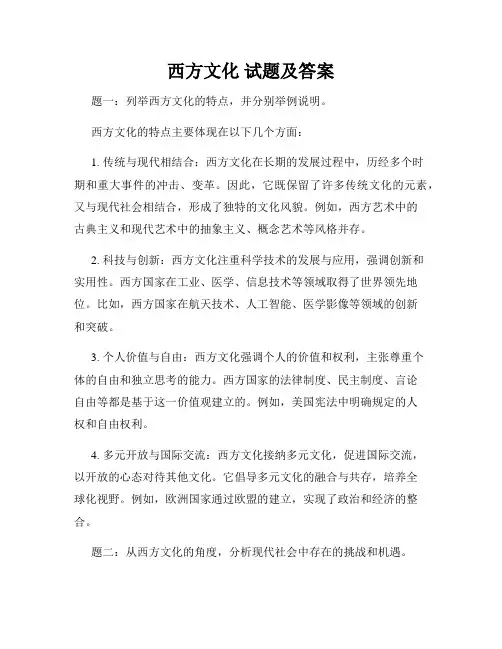
西方文化试题及答案题一:列举西方文化的特点,并分别举例说明。
西方文化的特点主要体现在以下几个方面:1. 传统与现代相结合:西方文化在长期的发展过程中,历经多个时期和重大事件的冲击、变革。
因此,它既保留了许多传统文化的元素,又与现代社会相结合,形成了独特的文化风貌。
例如,西方艺术中的古典主义和现代艺术中的抽象主义、概念艺术等风格并存。
2. 科技与创新:西方文化注重科学技术的发展与应用,强调创新和实用性。
西方国家在工业、医学、信息技术等领域取得了世界领先地位。
比如,西方国家在航天技术、人工智能、医学影像等领域的创新和突破。
3. 个人价值与自由:西方文化强调个人的价值和权利,主张尊重个体的自由和独立思考的能力。
西方国家的法律制度、民主制度、言论自由等都是基于这一价值观建立的。
例如,美国宪法中明确规定的人权和自由权利。
4. 多元开放与国际交流:西方文化接纳多元文化,促进国际交流,以开放的心态对待其他文化。
它倡导多元文化的融合与共存,培养全球化视野。
例如,欧洲国家通过欧盟的建立,实现了政治和经济的整合。
题二:从西方文化的角度,分析现代社会中存在的挑战和机遇。
西方文化在现代社会中既面临挑战,也有机遇。
1. 挑战:全球化带来的文化冲击。
随着全球化的推进,西方文化面临来自不同文化的冲击和竞争。
如何保持自身独特性、传统和核心价值面临挑战。
2. 机遇:文化多元促进创新与发展。
西方国家借助全球文化的融合,可以不断吸取其他文化的创新与发展经验。
多元文化的碰撞与融合,可以再次激发西方文化的活力和创造力。
3. 挑战:社会价值观的多元化和冲突。
随着社会的多元化发展,西方国家内部不同文化群体之间的价值观差异可能带来社会矛盾和冲突。
如何实现价值观的平衡与和谐是一个重要的挑战。
4. 机遇:推动全球性的社会问题解决。
作为先进的文化体系,西方文化具备解决全球性社会问题的能力。
例如,西方国家在气候变化、贫富差距、人权保护等领域的实践和经验可以为其他国家提供借鉴和启示。
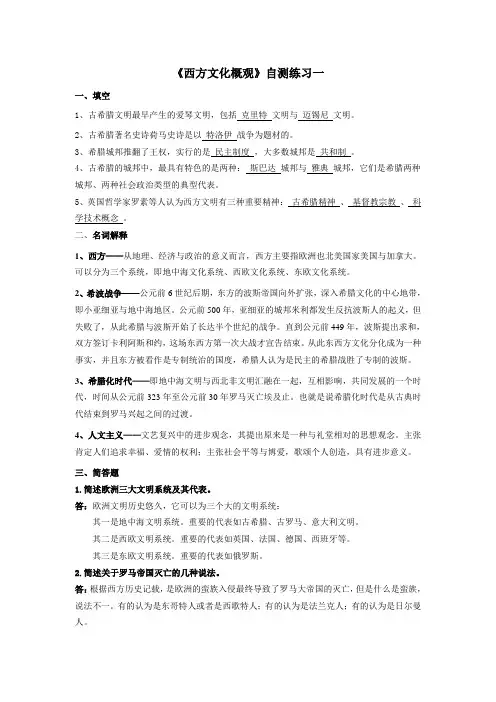
《西方文化概观》自测练习一一、填空1、古希腊文明最早产生的爱琴文明,包括克里特文明与迈锡尼文明。
2、古希腊著名史诗荷马史诗是以特洛伊战争为题材的。
3、希腊城邦推翻了王权,实行的是民主制度,大多数城邦是共和制。
4、古希腊的城邦中,最具有特色的是两种:斯巴达城邦与雅典城邦,它们是希腊两种城邦、两种社会政治类型的典型代表。
5、英国哲学家罗素等人认为西方文明有三种重要精神:古希腊精神、基督教宗教、科学技术概念。
二、名词解释1、西方——从地理、经济与政治的意义而言,西方主要指欧洲也北美国家美国与加拿大。
可以分为三个系统,即地中海文化系统、西欧文化系统、东欧文化系统。
2、希波战争——公元前6世纪后期,东方的波斯帝国向外扩张,深入希腊文化的中心地带,即小亚细亚与地中海地区。
公元前500年,亚细亚的城邦米利都发生反抗波斯人的起义,但失败了,从此希腊与波斯开始了长达半个世纪的战争。
直到公元前449年,波斯提出求和,双方签订卡利阿斯和约,这场东西方第一次大战才宣告结束。
从此东西方文化分化成为一种事实,并且东方被看作是专制统治的国度,希腊人认为是民主的希腊战胜了专制的波斯。
3、希腊化时代——即地中海文明与西北非文明汇融在一起,互相影响,共同发展的一个时代,时间从公元前323年至公元前30年罗马灭亡埃及止。
也就是说希腊化时代是从古典时代结束到罗马兴起之间的过渡。
4、人文主义——文艺复兴中的进步观念,其提出原来是一种与礼堂相对的思想观念。
主张肯定人们追求幸福、爱情的权利;主张社会平等与博爱,歌颂个人创造,具有进步意义。
三、简答题1.简述欧洲三大文明系统及其代表。
答:欧洲文明历史悠久,它可以为三个大的文明系统:其一是地中海文明系统。
重要的代表如古希腊、古罗马、意大利文明。
其二是西欧文明系统。
重要的代表如英国、法国、德国、西班牙等。
其三是东欧文明系统。
重要的代表如俄罗斯。
2.简述关于罗马帝国灭亡的几种说法。
答:根据西方历史记载,是欧洲的蛮族入侵最终导致了罗马大帝国的灭亡,但是什么是蛮族,说法不一。
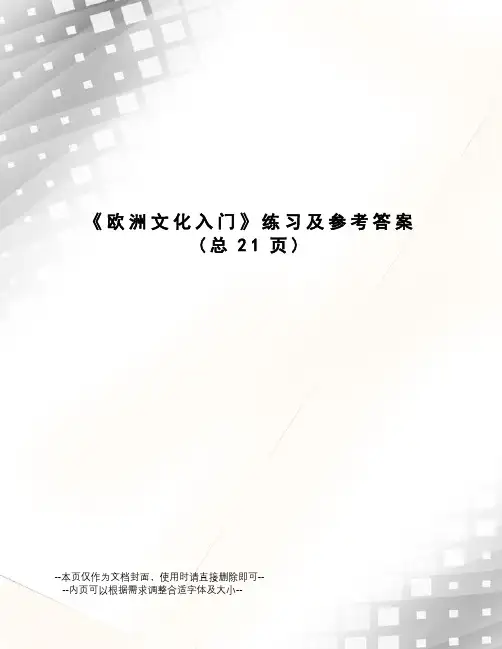
《欧洲文化入门》练习及参考答案(总21页)--本页仅作为文档封面,使用时请直接删除即可----内页可以根据需求调整合适字体及大小--欧洲文化入门各章练习及答案第一章填空题:1. The richness of European Culture was created by ________element and _________element. Greco-Roman Judeo-Christian2. The Homer’s epics consisted of_________. Iliad and Odyssey3. ________ is the first writer of “problem plays”. Euripides4. __________ is called “Father of History”. Herodotus5. ________is the greatest historian that ever lived. Thucydides6. The dividing range in the Roman history refers to ________. 27 .7. “I came, I saw, I conquered.” is a famous saying by _______. Julius Caesar8. The representation form of Greek Democracy is __________. citizen-assembly.判断题1. Euclid says “Give me a place to stand, and I will move the world”. (×) Archimedes2. Herodo tus’s historical writing is on the war between Anthens and Sparta. (×) Greeks and Persians名词解释:1. Pax Romana答:In the Roman history ,there came two hundred years of peaceful time, which was guaranteed by the Roman legions, it was known as Pax Romana2. “Democracy” in ancient Greece答: 1)Democracy means “exercise of power by the whole people”, but in Greece by “the whole people” the Greeks meant only the adult male citizens.2) Women, children, foreigners and slaves were excluded from Democracy. 论述题:1. How did the Greek Culture originate and develop1) Probably around 1200 ., a war was fought between Greece and troy. This is the war that Homer refers to in his epics.2) Greek culture reached a high point of development in the 5th century .A. The successful repulse of the Persian invasion early in the 5th century.B. The establishment of democracy.C. The flourishing of science, philosophy, literature, art and historical writing in Athens.3)The 5th century closed with civil war between Athens and Sparta.4) In the second half of the 4th century ., Greece was conquered by Alexander, king of Macedon. Whenever he wentand conquered, whenever Greek culture was found.5) Melting between Greek culture and Roman culture in 146 ., the Romans conquered Greece.2. What is the great significance of Greek Culture on the later-on cultural development答: There has been an enduring excitement about classical Greekculture in Europe and elsewhere Rediscovery of Greek culture played avital part in the Renaissance in Italy and other European countries.1) Spirit of innovationThe Greek people invented mathematics and science and philosophy; They first wrote history as opposed to mere annals; They speculatedfreely about the nature of the world and the ends of life, without being bound in the fetters ofany inherited orthodoxy.2) Supreme AchievementThe Greeks achieved supreme achievements in nearly all fields of human endeavour: Philosophy, science, epic poetry, comedy, historical writing, architecture, etc.3) Lasting effectA. Countless writers have quoted, borrowed from and otherwise used Homer’s epics, the tragedies of Aeschylus and Sophocles and Euripides, Aristophanes’s comedies, Plato’s Dialogues,ect.B. In the early part of the 19th century, in England alone, three young Romantic poets expressed their admiration of Greek culture in works which have themselves become classics: Byron’s Isles of Greece, Shelley’s Hellas and Prometheus Unbound and Keats’s Ode on a Grecian Urn.C. In the 20th century, there are Homeric parallels in the Irishman James Joyce’s modernist masterpiece Ulysses.3. What is the similarity and difference between Greek culture and Romanculture答:1) similarities:A. Both peoples had traditions rooted in the idea of the citizen-assembly.B. Their religions were alike enough for most of their deities to be readily identified, and their myths to be fused.C. Their languages worked in similar ways, both being members of the Indo-European language family.2) differences:A. The Romans built up a vast empire; the Greeks didn’t, except for the brief moment of Alexander’s conquests, which soon disintegrated.B. The Romans were confident in their own organizational power, their military and administrative capabilities.4. What is the Rome historical background答:1) The history of Rome divided into two periods: Before the year 27 ., Rome had been a republic; from the year 27 ., Octavius took supreme power as emperor with the title of Augustus and Roman Empire began.2) Two centuries later, the Roman Empire reached its climax, marked by land a rea’s extension: Encircling the Mediterranean.3) Strong military power: the famous Roman legions.4) In the Roman history ,there came two hundred years of peaceful time, which was guaranteed by the Roman legions,it was known as Pax Romana.5) Another important contribution made by the Romans to European culture was Roman Law.6) The empire began to decline in the 3rd century.A. In the 4th century the emperor Constantine moved the capital from Rome to it Constantinople (modern Istanbul).B. After 395, the empire was divided into East (The Byzantine Empire) and WestC. In 476 the last emperor of the West was deposed by Goths and this marked the end of the West Roman Empire.D. The East Roman Empire collapsed when Constantinople fell to the Turks in 1453.第二章填空题:1. ___________is by far the most influential in the West. Christianity2. The Hebrews history was recorded in _________of the Bible. the Old Testament3. The New Testament is about _________. the doctrine of Jesus Christ4. The story about God’s f looding to the human being and only good-virtue being saved was recorded in Genesis,Pentateuch, the Old Testament, the Bible, which was known as _________. Noah’s Ark.5. The Birth of Jesus was recorded in ________. Matthew6. The story about Jesus being pinned in the cross to death was known as_________. The Last Supper.7. The first English version of whole Bible was translated from the LatinVulgate in 1382 and was copied out by handby the early group of reformers led by _________. John Wycliff.名词解释:1. The Old TestamentThe Bible was divided into two sections: the Old Testament and the New Testament. The Old Testament is about God and the Laws of God. The word “Testament” means “agreement”, the agreement between God and Man.2. PentateuchThe Old Testament consists of 39 books, the oldest and most important of which are the first five books, called Pentateuch. Pentateuch contains five books: Genesis, Exodus, Leviticus, Numbers, Deuteronomy.3. GenesisGenesis is one of the five books in Pentateuch, it tells about a religious account of the origin of the Hebrews people, including the origin of the world and of man, the career of Issac and the life of Jacob and his son Joseph.4. ExodusExodus is one of the five books in Pentateuch, it tells about a religioushistory of the Hebrews during their flight from Egypt, the period when they began to receive God’s Law. Joshua brought the people safely back toCanaan.5. The Book of DanielThe Book of Daniel belongs to The Old Testament of the Bible. Ittells about the Hebrews being carried away into Babylon.论述简答题:1. What are the beliefs of Christianity答: Christianity based itself on two forceful beliefs which separate it fromall other religions.1)One is that Jesus Christ is the Son of God, and that God sent him to earth to live as humans live, suffer as humans suffer, and die to redeem mankind.2)The other is that God gave his only begotten son , so that whosoeverbelieves in him should not perish, but have everlasting life.2. What are the different translation editions of the Bible答:1)The oldest extant Greek translation of the Old Testament is known as the Septuagint. And it is still in use in the Greek Church today. But it only translated the Old Testament.2) The most ancient extant Latin version of the whole Bible is the Vulgate edition, which was done in 385-405 . By St. Jerome in common people’s language. It became the official Bible of the Roman Catholic Church throughout the world.3) The first English version of whole Bible was translated from the LatinVulgate in 1382 and was copied out by hand by the early group of reformers ledby John Wycliff.4) After John Wycliff’s version, appeared William Tyndale’s version. I t was based on the original Hebrew and Greek sources.5) The Great Bible ordered by Henry Ⅷ in 1539 to be placed in all the English churches was in part founded on Tyndale’s work.6) The most important and influential of English B ible is the “Authorized” or “King James” version, first published in 1611. It was produced by 54 biblical scholars at the command of King James. With its simple, majestic Anglo-Saxon tongue, it is known as the greatest book in the English languages.7) The Revised Version appeared in 1885, and the standard American edition ofthe Revised Version in 1901.8) The Good News Bible and the New English Bible.3. What is the great significance of the translations of the bible答:1) It is generally accepted that the English Bible and Shakespeare are two great reservoirs of Modern English.2) Miltion’s Paradise Lost, Bunyan’s Pilgrim’s Progress, Byron’s Cain, up to the contemporary Hemingway’s The Sun Also Rises, and Steinbeck’s East of Eden. They are not influenced without the effect of the Bible.第三章填空题:1. In _______ a Germanic (日耳曼) general killed the last Roman emperor and took control of the government. 4762. After 1054, the church was divided into _________ and _______. the Roman Catholic Church and the Eastern Orthodox Church.3. _______ is the one who translated into Latin both Old and New Testament from the Hebrew and Greek originals. St. Jerome4. ______introduced French and Italy writing the English native alliterative verse.5. Both ___________are the best representative of the middle English. Chaucerand The Canterbury Tales6. _________ paved the way for the development of what is the present-day European culture. the Middel Ages名词解释1. the Middle agesIn European history, the thousand-year period following the fall of the Western Roman Empire in the fifth century is called the Middle Ages. The middle ages is so called because it came between ancient times and modern times. To be specific, from the 5th century to 15th century.2. FeudalismFeudalism in Europe was mainly a system of land holding— a system of holding land in exchange for military service. The word “feudalism” was derived from the Latin “feudum”, a grant of land.3. The ManorThe centre of medieval life under feudalism was the manor. Manorswere founded on the fiefs of the lords. By the twelfth century manor houses were made of stone and designed as fortresses. They came to be called castles.4. Carolingian RenaissanceCarolingian Renaissance is derived from Charlemagne’s name in Latin, Carolus. The most interesting facet of this rather minor renaissance is the spectacle of Frankish or Germanic state reaching out to assimilate the riches of the Roman Classical and the Christianized Hebraic culture.5. Gothic1) The Gothic style started in France and quickly spread through all parts of Western Europe.2) It lasted from the mid-12th to the end of 15th century and, in some areas,into the 16th. More churches were built in this manner than in any other stylein history.3) The Gothic was an outgrowth of the Romanesque.论述简答题:1. Why is the middle ages is called Age of Faith答:1) During the Medieval times there was no central government to keep the order. The only organization that seemed to unite Europe was the Christian church.2) The Christian church continued to gain widespread power and influence.3) In the Late middle ages, almost everyone in western Europe wasa Christian and a member of the Christian Church. Christianity took the lead in politics, law, art, and learningfor hundreds of years.4) It shaped people’s lives. That is why the middle ages is also called the “Age of Faith”.2. What is the great significance of the Crusades答:1) The crusades brought the East into closer contact with the West. And they greatly influenced the history of Europe.2) During the wars while many of the feudal lords went to fight in Palestine, kings at home found opportunities to strengthen themselves. Thus among other things, Crusades helped to break down feudalism, which, in turn led to the rise of the monarchies.3) Besides, through their contact with the more cultured Byzantinesand Moslems, the western Europeans changed many of their old ideas. Their desire for wealth or power began to overshadow their religious ideals.4) The Crusades also resulted in renewing people’s interest in le arning and invention. By the 13th century, universities had spread all over Europe. Such knowledge as Arabic numerals, algebra , and Arab medicine were introduced to the West.5) As trade increased, village and towns began to grow into cities. And the rise of towns and trade in western Europe paved the way of the growth of strong national governments.3. How did learning and science develop in the Middle Ages答:1) Charlemagne and Carolingian Renaissance:A. He was crowned “Emperor of the Romans” by the pope in 800.B. Carolingian Renaissance is derived from Charlemagne’s name in Latin, Carolus. The most interesting facet of this rather minor renaissance is the spectacle of Frankish or Germanic state reaching out to assimilate the riches of the Roman Classical and the Christianized Hebraic culture.2) Alfred the Great and Wessex Centre of Learning:A. He promoted translations into the vernacular from Latin works.B. He also inspired the compilation of the Anglo-Saxon Chronicles.3) St. Thomas Aquinas and Scholasticism:4) Roger Bacon and Experimental Science:A. Roger Bacon, a monk, was one of the earliest advocates of scientific research.B. He called for careful observation and experimentation. His main work was the Opus maius.4. How did literature develop in the middle ages答:1) The epic was the product of the Heroic Age. It was an important and mostly used form in ancient literature.“National epic” refers to the epic written in verna cular languages—that is, the languages of various national states that came into being in the Middle Ages. Literary works were no longer all written in Latin. It was the starting pointof a gradual transition of European literature from Latin culture to a culture that was the combination of a variety of national characteristics. Both Beowulf and song of Roland were the representative works of the National Epics.2) Dante Alighieri and The Divine Comedy:A. His masterpiece, The Divine Comedy, is one of the landmarks of world literature.B. The poem expresses humanistic ideas which foreshadowed the spirit of Renaissance.C. Dante wrote his masterpiece in Italian rather than in Latin.3) Geoffery Chaucer and The Canterbury Tales:A. The Canterbury Tales were his most popular work.B. Most of the tales are written in verse which reflects Chaucer’s innovationby introducing into the native alliterativeverse the French and Italian styles.C. Chaucer is thus to be , regarded as the first short story teller and thefirst modern poet in English literature.D. Chaucer and the Canterbury Tales were representative of the Middle ages.5. What is the difference between the vernacular language used in the National epics and the vernacular language used by Mark twain答:1) The epic was the product of the Heroic Age. It was an important and mostly used form in ancient literature.“National epic” refers to the epic written in vernacular languages—that is, the languages of various national states that came into being in the Middle Ages.Literary works were no longer all written in Latin. It was the starting pointof a gradual transition of European literature from Latin culture to a culture that was the combination of a variety of national characteristics. Both Beowulf and song of Roland were the representative works of the National Epics.2) The vernacular language used by Mark twain refers to both local and colloq language used in the Mississippi area, with a strong characteristic of that region. Mark twain used vernacular language not only in dialogue, but also in narration.3) His representative works Life on the Mississippi.6. What were the power and influence of the Roman Catholic church in theMedieval times1) With a highly centralized and disciplined international organization from priests to Pope, the Roman Catholic Church seemed to be the only unity across the western Europe of the Medieval times. It developed a civilization based on Christianity and helped to preserve and pass on the heritage of the classical cultures by the official language of Latin.2) with the Pope as the supreme head of all the Christian Churchesof the western Europe, the Catholic (meaning universal) church received heavy taxes from lay people and various supports from nobles and kings. Church could remove any opponents political rights or even emperors,with the powerful symbol of the Inquisition, the Church court to punish heresy.3) The Medieval Church was the center of the Europeans’ daily life and almost everyone became a member of theChurch. People turned to the Church for comfort and spiritual guidance; the Church also was the center of holy communion, recreation, trade and communal activity.4) Clergy then was the only literate class, so kings and nobles used them to implement important secular governmental duties.5) The Church took the lead in politics, law, art, and learning throughout the “Age of Faith”. For example, Romanesque and Gothic arts were predominantly religious; in learning, it influenced greatly the western thinking with the monks’ work on copying and translating ancient books, the ChurchFathers’ philosop hy, Monasticism, Scholasticism and Experimental science.6) originally for regaining the holy city of Jerusalem, the Church launched 200-year Crusades, which helped to bread down feudalism and enhanced the cultural contact between the West and the East.第四章填空题:1. Renaissance started in ________ and ________ with the flowering of paintings, sculpture and architecture. Florence and Venice.2. In Renaissance literature of Italy, _______ was the representative poet. Petrarch3. At the heart of the Renaissance philosophy was the assertion of _________. the greatness of man.4. The idea of the greatness of man is reflected in __________ literature. Shakespeare’s5. The national religion established after reformation in England was called _______. The church of England or The Anglican Church.6. It was under the reign of _______ that reformation was successful in England. Henry Ⅷ.7. Montaigne was a French humanist known for his _______. “Essais”(Essays).8. The representative novelist of Renaissance in Spain was __________ with his famous work_______, which marked European culture entry into a new stage. Cervantes Don Quixote9. The Venus of Urbino is ___________ works. Titian10. _______ translated the whole Bible with the vernacular language. Martin Luther名词解释:1. RenaissanceGenerally speaking, Renaissance refers to the period between the 14th and mid-17th century. The word “Renaissance” means revival, specifically in this period of history, revival of interest in ancient Greek and Roman culture. Renaissance, in essence, was a historical period in which the European humanist thinkers and scholars made attempts to get rid of conservatism in feudalist Europe and introduce new ideas that expressed the interests of the rising bourgeoisie, to lift the restrictions in all areas placed by the Roman church authorities.2. ReformationThe Reformation was a 16th century religious movement as well as a socio-political movement. It began as Martin Luther posted on the door of the castle church at the University of Wittenberg his 95 thesis. This movement which swept over the whole of Europe was aimed atopposing the absolute authority of the Roman Catholic Church and replacing it with the absolute authority of the Bible. The reformists engaged themselves in translating the Bible into their mother tongues.3. Counter-ReformationBy late 1520 the Roman Catholic Church had lost its control overthe church in Germany. The Roman Catholic Church did not stay idle. They mustered their forces, the dedicated Catholic groups, to examine the Church institutions and introduce reforms and improvements, to bring back its vitality. This recovery of power is often called by historiansthe Counter-Reformation.论述简答题:1. What are the Geographical Discoveries in the Renaissance答:The Renaissance was the golden age of geographical discoveries: by the year of 1600 the surface of the known earth was doubled.1)Columbus: Columbus discovered the land of America. On his fourth voyage he explored the coast of Central America.2)Dias: Dias was a Portuguese navigator who discovered the Cape of Good Hope in 1487.3)Da Gama: Gama was a Portuguese navigator, who discovered the route to India round the Cape of Good Hope between the years of 1497 and 1498.4)Amerig:Amerigo was the Italian navigator on whose honour America was named. His discovered and explored the mouth of the Amazon and accepted South Americaas a new continent.2. What positive influence does the reformation exert on world culture答:1)The Roman Catholic Church was never the international court to which all rulers and states were to be morally responsible for.2)Economically, peasants all over Europe had no need to pay a good amount oftheir gains to the Pope.3)In educational and cultural matters, the monopoly of the church was broken.4)In religion, Protestantism brought into being different forms of Christianity to challenge the absolute rule of the Roman Catholic Church.5)In language, the dominant position of Latin had to give way to the national languages as a result of various translations of the Bible into the vernacular.6)In spirit, absolute obedience became out-moded and the spirit of quest,debate , was ushered in by the reformists.3. What contribution did the Renaissance make to the world culture答:1、The Renaissance created a culture which freed man to discover and enjoy the world in a way not possible under the medieval Church’s dispensation.2、The Reformation dealt the feudal theocracy a fatal blow.第五章填空题:1. The modern world, so far as mental outlook is concerned, begins in ________. the 17th century2. _________ formed the basis of all modern planetary astronomy and led to Newton’s discovery of the laws of gravitation. Kepler’s Laws3. “Knowledge is power.” By _____. Francis Bacon4. Some books are to be tasted, others to be swallowed, and some few to be chewed and digested. By _____. Francis Bacon5. Leviathan is written by ________. Tomas Hobbes6. The English Revolution is also called __________. Bourgeoisie Revolution.7. In _______, the Bill of Rights was enacted by the English Parliament. 16898. There are two leaders in the English Revolution. _______ was the man of action and ________ the man of thought. Cromwell, Milton.9. The best representative of French neoclassicism is ________. Molière名词解释:1. the laws of gravitation: the sun, the moon, the earth, the planets, and all the other bodies in the universe move in accordance with the same basic force, which is call gravitation.2. ClassicismClassicism implies the revival of the forms and traditions of the ancient world, a return to works of old Greek literature from Homer to Plato and Aristotle. But French classicism of the 17th century was not conscious of being a classical revival. It intended to produce a literature, French to the core, which was worthy of Greek and classical ideals.This neoclassicism reached its climax in France in the 17th century.3. Baroque ArtBaroque Art, flourished first in Italy, and then spread to Spain, Portugal, France in south Europe and to Flander and the Netherlands in the North. It was characterized by dramatic intensity and sentimental appeal with a lot of emphasis on light and colour.论述简答1. Why do we say the 17th century is a transitional period from middle ages to the modern times答:1) This advance began in science, in astronomy, physics and pure mathematics, owing to the work of Galileo, Kepler, Newton and Descartes. 2) The outlook of educated men was transformed. There was a profound change in the conception of men’s place in the universe.3) The new science and philosophy gave a great push to the political struggle waged by the newly emerged class, the bourgeoisie, and other chasses.4) The modern world, so far as mental outlook is concerned, begins in the 17th century.2. What are the merits shared by the Great Scientists of 17th century答:During the 17th century, the modern Scientific method began totake shape. It emphasized observation and experimentation beforeformulating a final explanation or generalization. Copernicus、Kepler、Galileo、Newton and other scientists of the time shared two merits which favoured the advance of science.1) First, they showed boldness in framing hypotheses.2) Second, they all had immense patience in observation.3) The combination of the two merits brought about fundamental changes in man’s scientific and philosophical thinking.3. What is Baconian Philosophical system答:1) The whole basis of his philosophy was practical: to give mankind mastery over the forces of nature by means of scientific discoveries and inventions.2) He held that philosophy should be kept separate from theology, not intimately be blended with it as in Scholasticism.3) Bacon established the inductive method. Induction means reasoning from particular facts or individual cases to a general conclusion.. Deductive method emphasized reasoning from a known principle to the unknown and from thegeneral to the specific.4) In a word, to break with the past, and to restore man to his lost mastery of the natural world. This was what Bacon called the Great Instauration.4. What is the difference between Hobbes and Locke in terms of nature Law答:For Locke, Nature Law, therefore, means a universally obligatory moral law promulgated by the human reason. Whereas for Hobbes it means the law of power, force and fraud.5. What is the different between Tomas Hobbes and John Locke in terms of Social Contract1) John Lock’s Social Contract consists of :A. Society is out of necessity, convenience and man’s own interest, and therefore, society is natural to man.B. The institution of political society and government must proceed from the consent of those who are incorporated into political society and subject themselves to government.C. Locke emphasized that the social contract must be understood as involving the individual’s consent to submit to the will of the majority and that the will of the majority must prevail.D. Locke also believed that the ruler of government is one partner of the social contract. If he violates the social contract, then government is effectively dissolved. This idea was welcomed by the Americans during the AmericanRevolution and the bourgeoisie revolution in England.2 Tomas Hobbes’ Social Contract consists of:A. It is necessary that there should be a common power or government backed by force and able to punish.B. Commonwealth, in Latin, Civitas.C. To escape anarchy, men enter into a social contract, by which they submit to the sovereign. In return for conferring all their powers and strength to the sovereign, men attain peace and security.D. The powers of the sovereign must be absolute, and it is only be the centralization of authority in one person that the evil can be avoided.E. As to the form of government, Hobbes preferred monarchy.F. Government was not created by God, but by men themselves.3) Although both Tomas Hob bes and John Locke used the term “social contract”, they differed fundamentally.A. Firstly, Hobbes argued men enter a social contract to escape the state of war, for, in his view, men are enemies and at war with each other. Locke argued men are equal and that they enter a social contract by reason.。
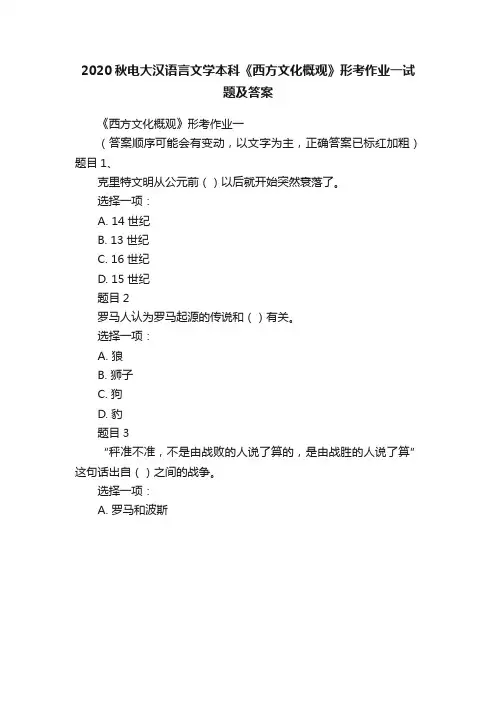
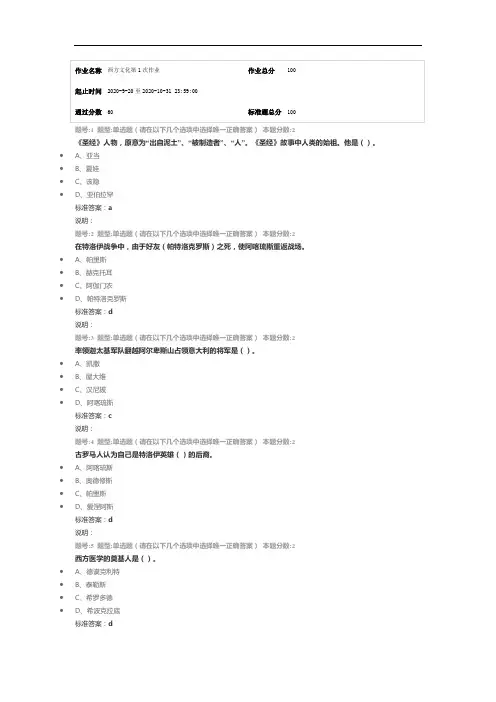
说明:题号:6 题型:判断题本题分数:3文艺复兴在字面上是指“古希腊罗马文化的复兴”,而实质上是欧洲社会转型期(15-17世纪)发生的一次重大的思想文化运动。
在“复兴”古希腊罗马文化的旗帜下,文艺复兴运动运用“人文主义”的思想武器对当时的封建主义和宗教神学思想进行了批判,为欧洲进入现代工业社会奠定了文化思想的基础。
•1、错•2、对标准答案:2说明:题号:7 题型:判断题本题分数:3北美殖民地时期的文学是在印第安人文学的基础上发展起来的。
虽然这时期没有产生较高水平的文学作品,但也出现了具有清教主义特色,或带有类似圣经风格、或宣传人道主义思想的文学作品。
•1、错•2、对标准答案:1说明:题号:8 题型:判断题本题分数:319世纪五六十年代.英国的现实主义正处于巅峰状态,文坛上就响起了与之迥然相异的另类声音。
“为艺术而艺术”,还是“为现实而艺术”,人们为艺术的发展竖起了截然相反的方向标。
•1、错•2、对标准答案:2说明:题号:9 题型:判断题本题分数:32100 BC 以后移居在意大利半岛中部拉丁姆平原上的拉丁部落人创立了拉丁文化,他们后来接受了希腊文化,并在753 BC 建立了罗马城,是一个实行军事民主的农业社会。
•1、错•2、对标准答案:2说明:题号:10 题型:判断题本题分数:3莫里哀(1622-1673)是英国最杰出的喜剧家之一。
他是古典主义作家,但并不拘泥于古典主义法则。
他的喜剧具有鲜明的反封建、反教会的特色,但也带有宫廷色彩。
•1、错•2、对标准答案:1说明:题号:11 题型:判断题本题分数:3荷马时代正是希腊神话的形成时期,古希腊人信奉多神教,赫西俄德曾创作了一部神的史诗——《神谱》,主要描写“奥林匹斯神系”,前后两辈。
•1、错•2、对标准答案:1说明:题号:12 题型:判断题本题分数:3苏格拉底是开创希腊哲学研究新方向的划时代的思想家,他把研究对象从自然转向了社会和人类的内心世界,专门探讨人类的心灵智慧与活动能力.•1、错•2、对标准答案:2说明:题号:13 题型:判断题本题分数:3在公元313年君士坦丁颁布“米兰赦令”,宣布给基督教以合法地位。
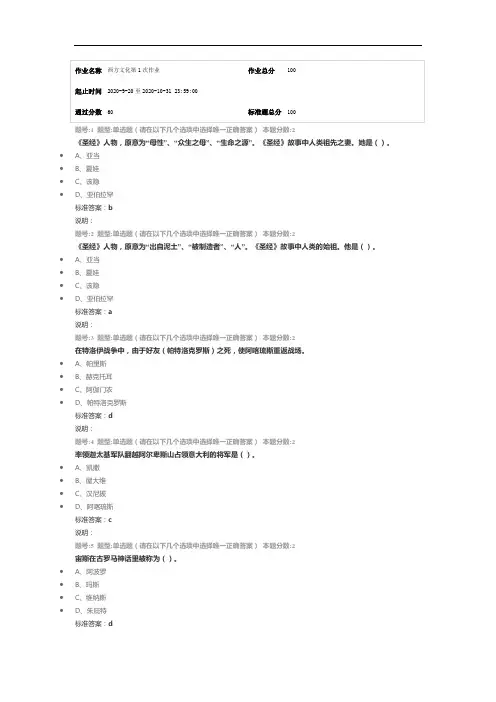
说明:题号:6 题型:判断题本题分数:3文艺复兴在字面上是指“古希腊罗马文化的复兴”,而实质上是欧洲社会转型期(15-17世纪)发生的一次重大的思想文化运动。
在“复兴”古希腊罗马文化的旗帜下,文艺复兴运动运用“人文主义”的思想武器对当时的封建主义和宗教神学思想进行了批判,为欧洲进入现代工业社会奠定了文化思想的基础。
•1、错•2、对标准答案:2说明:题号:7 题型:判断题本题分数:319世纪五六十年代.英国的现实主义正处于巅峰状态,文坛上就响起了与之迥然相异的另类声音。
“为艺术而艺术”,还是“为现实而艺术”,人们为艺术的发展竖起了截然相反的方向标。
•1、错•2、对标准答案:2说明:题号:8 题型:判断题本题分数:32100 BC 以后移居在意大利半岛中部拉丁姆平原上的拉丁部落人创立了拉丁文化,他们后来接受了希腊文化,并在753 BC 建立了罗马城,是一个实行军事民主的农业社会。
•1、错•2、对标准答案:2说明:题号:9 题型:判断题本题分数:3莫里哀(1622-1673)是英国最杰出的喜剧家之一。
他是古典主义作家,但并不拘泥于古典主义法则。
他的喜剧具有鲜明的反封建、反教会的特色,但也带有宫廷色彩。
•1、错•2、对标准答案:1说明:题号:10 题型:判断题本题分数:3荷马时代正是希腊神话的形成时期,古希腊人信奉多神教,赫西俄德曾创作了一部神的史诗——《神谱》,主要描写“奥林匹斯神系”,前后两辈。
•1、错•2、对标准答案:1说明:题号:11 题型:判断题本题分数:3在公元313年君士坦丁颁布“米兰赦令”,宣布给基督教以合法地位。
到11世纪下半期,西方基督教也取得了对东正教和伊斯兰教世界的优势。
•1、错•2、对标准答案:2说明:题号:12 题型:判断题本题分数:3苏格拉底是开创希腊哲学研究新方向的划时代的思想家,他把研究对象从自然转向了社会和人类的内心世界,专门探讨人类的心灵智慧与活动能力.•1、错•2、对标准答案:2说明:题号:13 题型:判断题本题分数:3波斯位于美索不达米亚西面由高山环绕的高原上,以公元前538年占领巴比伦并继承亚述帝国的人种而命名,现在这个国家叫伊朗。
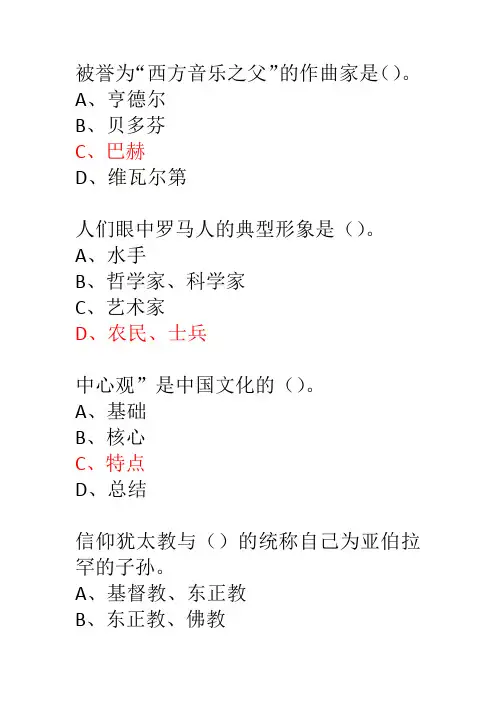
被誉为“西方音乐之父”的作曲家是()。
A、亨德尔B、贝多芬C、巴赫D、维瓦尔第人们眼中罗马人的典型形象是()。
A、水手B、哲学家、科学家C、艺术家D、农民、士兵中心观”是中国文化的()。
A、基础B、核心C、特点D、总结信仰犹太教与()的统称自己为亚伯拉罕的子孙。
A、基督教、东正教B、东正教、佛教C、基督教、伊斯兰教D、伊斯兰教、东正教人类最早的文字是()。
A、甲骨文字B、埃及纸草C、楔形文字D、欧洲字母表描述文明特征与内容需要考虑的因素中不包括()。
A、地理环境B、制度设施C、生活方式D、教育水平“关涉大家的事要得到大家的同意”是中世纪代议制民主的()。
A、含义B、特征C、程序设计D、基本原则宪政制度的()是将人心、人性定义为恶。
A、最大特点B、最基本前提C、最重要体现D、核心《老子》和《庄子》是()学说的代表作品。
A、儒家B、佛家C、道家D、法家英国在宗教改革中建立的民族教会,也称为()。
正确为AA、安立甘教会B、英格兰教会C、民族圣公会D、安立甘圣公会()建筑的文化内涵表现出了人与神的隔绝、疏远。
A、希腊式B、罗马式C、哥特式D、文艺复兴式下列音乐作品属于新古典主义在德国的表现的是()。
A、《第三交响乐》B、《乐章三首》C、《无主之锤》D、《画家马蒂斯》当代关于“公法”与“私法”的区分有不同学说,其中不包括()。
A、利益说B、隶属说C、文化说D、主体说日本《民法典》是界于()之间的混合产物。
A、英国《民法典》和德国《民法典》B、法国《民法典》和中国《民法典》C、法国《民法典》和德国《民法典》D、美国国《民法典》和德国《民法典》古罗马政治结构的多元化表现在()。
A、多国并立B、封建制度C、政教二元化D、国家二分关于弗洛伊德,说法不正确的是()。
A、主要研究癔病B、发明了谈疗法C、澳大利亚心理学家D、精神分析学派的创始人古代等级社会中“不平等的人之间不平等”,这种“不平等”是基于()。
A、身份B、本性C、性别D、资本文明作为价值尺度的内在要素,并未体现在()。
西方文化概论任务1附答案单选题(1/20)、斯巴达社会分为三个阶层,居统治地位的是(),其次是(),即边民或邻人,最下层是(),即在斯巴达人的征服活动中沦为奴隶的土著民族。
这三个阶层依次为()。
(2分)A、斯巴达人柏里赛人希洛人B、柏里赛人斯巴达人希洛人C、希洛人柏里赛人斯巴达人D、希洛人斯巴达人柏里赛人(2/20)、雅典的立法权属于“公民大众”,它由()组成。
(2分)A、全体雅典公民B、五百公民C、上层与中层公民D、上层公民(3/20)、毕达哥拉斯把万物的本原说成是一种超自然形态的东西,即()。
(2分)A、形体B、道理C、数D、艺术(4/20)、公元前336年,于希腊北部的马其顿王国由()继承腓力二世的王位,将松散的希腊联盟“科林斯同盟”整合为一个的马其顿帝国。
1章/3节 (2分)A、亚历山大B、托勒密C、塞琉谷(5/20)、绚丽多姿的希腊神话是不同文化长期融合的结果,其中主要是()世界神话与北方印欧语世界神话融合的结果。
(2分)A、地中海B、红海C、里海D、黑海(6/20)、首届奥林匹克竞技会于公元前()年举行。
(2分)A、774B、775C、777D、776(7/20)、罗马著名医生()提出了血液循环和“动物元气”的理论,第一次将人体看作一个有机的整体。
(2分)A、盖伦B、华佗C、达?芬达(8/20)、希腊哲学和科学思想的集大成者是()。
(2分)A、柏拉图B、苏格拉底C、亚里士多德D、毕达哥拉斯(9/20)、在希波战争中,为了共同御敌的需要,雅典人联合爱琴海地区的一些希腊城邦组建了()。
战后,“同盟”逐渐变成了一个“帝国”,雅典人从自由主和分离主义的楷模走向了帝国主义。
另一方面,希腊另一大城邦斯巴达则在希腊半岛南部建立了伯罗奔尼撒同盟,与提洛同盟争夺希腊霸权。
(2分)A、提洛同盟B、伯罗奔尼撒同盟C、北约组织(10/20)、希腊的哲学之父是()。
(2分)A、泰勒斯B、毕达哥拉斯C、苏格拉底D、柏拉图(11/20)、在约元前15世纪左右,一场突如其来的灾难使得米诺斯王国迅速衰亡,克里特文明奇迹般地消失了。
(2011春)西方行政制度第一次作业参考答案一、名词解释1 、行政国家行政机关等行政主体为实现国家目标和统治阶级利益,依照宪法和法律的规定、组织和管理国家政务、社会公共事务和自身内部事务的执行活动2、行政制度行政制度即政府制度,是以一定的行政思想和观念作指导的、有国家宪法和法律规定的有关国家机关的产生、职能、权限、组织结构、领导体制、活动规程等方面的准则体系以及政府体制内各权力主体的关系形态3、内阁制内阁制亦称议会制,政府制度或责任内阁制度,或内阁执政府制度。
4、国务院制国务院制度是指中国最高国家行政机关---国务院又全国人民代表大会产生并对其负责、受其监督的政府制度。
二、简答题1、行政制度的分类第一、亚里士多德认为,政体按最高统治者人数的多少和统治的目的,可以分为三种:君主政体、贵族政体和共和政体。
第二、君主立宪制和民主共和制的概念。
第三、单一制和联邦制的概念、代表性国家。
2 行政制度的特征第一、环境的制约性。
第二、鲜明的阶级性。
第三、效力的强制性。
第四、形式的多样性。
3、比较研究的目的和意义(1)开展中外政府行政制度的比较研究,有助于我们丰富政府制度知识,提升对政府制度问题的分析能力。
(2)开展中外政府行政制度的比较研究,有助于我们探究比较政府制度的学科体系,繁荣马克思主义的政治科学。
(3)开展中外政府行政制度的比较研究,有助于我们借鉴和吸收外国政府制度中的合理因素,促进我国政府制度的改革和完善4、总统政府制度及其特征总统独立于国会之外总统一人兼任国家元首和政府首脑政府于国会完全分离政府成员与总统僚僚属关系政府不对国会负连带责任三、论述题1、西方政府制度的不同点(1)政府制度的形成路径不同。
(2)政府组成的方式不同。
(3)政府与议会的关系不同(4)内阁的地位与作用不同(5)内阁的成员的构成及其关系不同2、中西政府制度的区别点制度性质不同。
依循原则不同(2011春)西方行政制度第二次大作业参考答案一、名词解释1、国家元首制度国家元首制度是对内对外的最高代表,是国家的象征,是国家机构的重要组成部分。
2.罗马法契约自由思想对后世法律的影响是巨大的。
无论是《法国民法典》对契约自由的极度扩张也好,还是《德国民法典》对契约自由的诸多限制也好,它们都是建立在对罗马契约自由思想的继受基础上的,是这一思想在不同历史时期的不同表现。
当然,罗马契约自由思想的影响不限于此,事实上它早已超越了大陆法系和民法范畴,对英美契约法的发展和资产阶级国家学说(如卢梭的“社会契约论”就曾受其启发)的创立都发生过重要影响。
3.基督教会在西欧中世纪的积极作用朱伟奇提要基督教会在西欧中世纪历史上起到了不可低估的积极作用,它不仅继承发展了古代罗马的文明,而且重新创建了西欧社会的文明。
关键词基督教会文明使者拓荒者关于基督教会在西欧中世纪的历史作用问题,众说纷纭,褒贬不一,但总体上讲.中世纪千年的黑暗,就是基督教在欧洲造成的。
文艺复兴、启蒙运动、工业革命,是对基督教的反抗。
正是因为反抗基督教,欧洲才走上了文明富强。
4达芬奇。
蒙娜丽莎》神秘的微笑莫衷一是。
不同的观者或在不同的时间去看,感受似乎都不同。
有时觉得她笑得舒畅温柔,有时又显得严肃,有时像是略含哀伤,有时甚至显出讥嘲和揶揄。
4最后的晚餐.画面呈现的是耶酥被他的弟子犹大出卖后被捕的第一天,与12个弟子共进最后一次晚餐时的情景。
4米开朗基罗。
大卫。
从艺术效果来看,这种矛盾高潮到来之前的状态更富有吸引力。
从思想效果上说,雕像充分体现了一种顽强、坚定和正义的精神气质。
米开朗基罗把大卫作为保卫共和制城市的一名青年战士的典型来塑造,这反映了他的政治思想。
在艺术技巧上,艺术家以解剖学为基础,对人体结构和全身的筋肉都表现得极为合理极为自然,同时对手的关节和大腿加上夸张加长,手和脚稍大,这对一个少年来说是正常的。
面部表情也非常逼真,他双眉紧锁,目光炯炯,全神贯注,显示出压倒一切敌人的威武姿态。
这件作品成为后世艺术家学习雕塑的楷模,是雕塑史上最杰出的作品之一。
4米开朗基罗.《摩西》、《被缚的奴隶》和《垂死的奴隶》。
题号:1 题型:单选题(请在以下几个选项中选择唯一正确答案)本题分数:2德国古典唯心主义哲学的创始人()。
主要著作有《自然通史和天体理论》、《纯粹理性批判》、《实践理性批判》、《判断力批判》等。
•A、康德•B、黑格尔•C、费希特•D、费尔巴哈学员答案:a说明:本题得分:2题号:2 题型:单选题(请在以下几个选项中选择唯一正确答案)本题分数:2《圣经》人物,原意为“母性”、“众生之母”、“生命之源”。
《圣经》故事中人类祖先之妻。
她是()。
•A、亚当•B、夏娃•C、该隐•D、亚伯拉罕学员答案:b说明:本题得分:2题号:3 题型:单选题(请在以下几个选项中选择唯一正确答案)本题分数:2古希腊“爱和美之神”在古罗马神话里叫()。
•A、阿波罗•B、雅典娜•C、阿瑞斯•D、维纳斯学员答案:d说明:本题得分:2题号:4 题型:单选题(请在以下几个选项中选择唯一正确答案)本题分数:2被誉为古希腊“哲学之父”的哲学家是()。
•A、希罗多德•B、阿里斯托芬•C、索福克勒斯•D、泰勒斯学员答案:d说明:本题得分:2题号:5 题型:单选题(请在以下几个选项中选择唯一正确答案)本题分数:2古罗马人认为自己是特洛伊英雄()的后裔。
•A、阿喀琉斯•B、奥德修斯•C、帕里斯•D、爱涅阿斯学员答案:d说明:本题得分:2题号:6 题型:判断题本题分数:3文艺复兴在字面上是指“古希腊罗马文化的复兴”,而实质上是欧洲社会转型期(15-17世纪)发生的一次重大的思想文化运动。
在“复兴”古希腊罗马文化的旗帜下,文艺复兴运动运用“人文主义”的思想武器对当时的封建主义和宗教神学思想进行了批判,为欧洲进入现代工业社会奠定了文化思想的基础。
•1、错•2、对学员答案:2说明:本题得分:3题号:7 题型:判断题本题分数:3北美殖民地时期的文学是在印第安人文学的基础上发展起来的。
虽然这时期没有产生较高水平的文学作品,但也出现了具有清教主义特色,或带有类似圣经风格、或宣传人道主义思想的文学作品。
《西方文化概论》课程论文学院:专业:班级:学号:姓名:本论文根据结课论文评分标准,应得分值课程论文的成绩评定采用五级记分制,即优秀(90-100分)、良好(80-90分)、中等(70-79分)、及格(60-69分)、不及格(60分以下)。
1、优秀(90-100分)能熟练地综合运用所学理论和专业知识,内容丰富,立论正确,分析严密,结论合理;论文有自己独到的见解,具有一定的创新性,水平较高论文条理清楚,论述充分,文字通顺,符号统一,编号齐全,书写工整,格式规范。
2. 良好(80-90分)按期完成论文的各项工作,能较好地综合运用所学理论和专业知识,内容较丰富,立论正确,分析正确,结论合理;论文有一定的水平。
论文条理清楚,论述充分,文字通顺,符合学术用语要求,书写工整,格式规范。
3. 中等(70-79分)在运用所学理论和专业知识上基本正确,但在非主要内容上有欠缺和不足;立论正确,分析基本正确;有一定的独立工作能力;论文水平一般。
论文文理通顺,但论述有个别错误或表达不清楚,书写不够工整,格式不够规范。
4. 及格(60-69分)在运用所学理论和专业知识上没有大的原则性错误;论点、论据基本成立,分析基本正确,内容欠丰富;论文达到基本要求。
论文文理通顺,但论述不够恰当和清晰;书写欠工整,格式欠规范。
5. 不及格(60分以下)在运用所学理论和专业知识上出现不应有的原则性错误;在分析等工作中独立工作能力差;内容比较少,论文未达到基本要求。
论文文理不通,书写潦草,格式不规范。
说明:(1)未写题目扣2分。
(2)错别字1个扣1分,至多扣3分。
(3)标点错误多,酌情扣1—2分。
(4)文面不整洁,酌情扣1—2分;文面整洁美观,酌情加1—2分。
外国文学基础第一次一、单项选择题(共10 道试题,共20 分。
每题2分,共20分,答错不得分)1.堂吉诃德主要是一个怎样的形象?bA. 地主B. 游侠C. 农民D. 士兵2.A. 亨利•费尔丁B. 丹尼尔•笛福C. 萨谬尔•理查逊D. 约拿旦•斯威夫特3. 薄伽丘的代表作品是:dA. 《疯狂的罗兰》B. 《爱的幻影》C. 《名人的命运》D. 《十日谈》4. “文艺复兴”这个词一般用来概括哪个时期从意大利开始、后来遍布整个欧洲的思想文化运动?aA. 14世纪到16世纪B. 12世纪到16世纪C. 16世纪到17世纪D. 15世纪到17世纪5. 下列不属于法国古典主义悲剧作家高乃依的作品是:bA. 《熙德》B. 《费德尔》C. 《贺拉斯》D. 《尼高梅德》6. 《人间喜剧》的作者是:aA. 巴尔扎克B. 雨果C. 普希金D. 司汤达7. 《红与黑》的作者是:dA. 巴尔扎克B. 莫泊桑C. 易卜生D. 司汤达8. 由达达主义“脱身”出来的流派是:dA. 魔幻现实主义B. 超现实主义C. 未来主义D. 存在主义9. 《包法利夫人》的女主人公是:bA. 娜拉B. 爱玛C. 羊脂球D. 安娜10. 下面哪一部戏剧不属于莎士比亚的四大悲剧:dA. 《哈姆雷特》B. 《奥瑟罗》C. 《李尔王》D. 《威尼斯商人》1b 3d4a5b6a7d8d9b10d二、多项选择题(共5 道试题,共20 分。
每题4分,共20分,多选、漏选、选错均不得分)1. 下列属于易卜生的“社会问题剧”的作品有:BCEA. 《海上夫人》B. 《群鬼》C. 《玩偶之家》D. 《建筑师》E. 《青年同盟》2. 下列作者中是意大利作家的有:ABCA. 但丁B. 薄迦丘C. 彼特拉克D.拉伯雷E. 塞万提斯3. 人文主义文学的特点ABEA. 具有鲜明的反封建、反教会的进步倾向B. 注意写实,反映广阔的社会生活,但这一时期的现实主义作品中还保留着许多传统因素,并与浪漫主义结合在一起C. 善于塑造栩栩如生的艺术形象,着重从道德心理上进行刻画,而不注重对人们的客观物质关系进行分析D. 人物性格复杂而完整E. 注重民族特色,表现爱国情绪,用民族语言进行写作4. 象征主义的代表作家有:ABEA. 瓦雷里B. 艾略特C. 斯坦贝克D. 布莱希特E. 里尔克5. 下列作品中是歌德创作的有:AEA. 《少年维特之烦恼》B. 《威廉·退尔》C. 《汉堡剧评》D. 《强盗》E. 《浮士德》三、简答题(共3 道试题,共30分。
作业名称:西方文化第1次作业出卷人:SA作业总分:100 通过分数:60起止时间:2015-4-20 11:29:58 至 2015-4-20 12:04:56学员姓名:14030110608 学员成绩:90标准题总分:100 标准题得分:90详细信息:题号:1 题型:单选题(请在以下几个选项中选择唯一正确答案)本题分数:2内容:恺撒是罗马最伟大的军事领袖,他作为独裁官所采取的一系列措施也确实产生了深远的影响,英语中一年的第()个月也以恺撒的名命名的A、五B、六C、七D、八学员答案:C本题得分:2题号:2 题型:单选题(请在以下几个选项中选择唯一正确答案)本题分数:2内容:超验主义是一场思想解放运动,先表现为宗教,哲学思想中的改革,后扩展到文学创作领域,这一派思想的出发点是()。
A、理性主义B、人文主义C、心理体验D、实验文学学员答案:B本题得分:2题号:3 题型:单选题(请在以下几个选项中选择唯一正确答案)本题分数:2内容:( )是后亚历山大时代希腊科学和学术所使用的语言,其时的科学和学术中心已不是雅典,而是尼罗河畔的亚历山大城.A、希腊文B、波斯语C、古希腊共同语D、克里特语学员答案:C本题得分:2题号:4 题型:单选题(请在以下几个选项中选择唯一正确答案)本题分数:2内容:泰勒斯、阿纳克西曼德和阿纳克西美尼这三位早期哲学家均来自一个地方,且保持着师承关系,因而被称作()A、米诺斯学派B、米利都学派C、希腊学派D、经院学派学员答案:B本题得分:2题号:5 题型:单选题(请在以下几个选项中选择唯一正确答案)本题分数:2 内容:在希波战争中,率领300名斯巴达战士抵抗几十万波斯大军的斯巴达国王是()。
A、李奥尼达B、屋大维C、汉尼拔D、君士坦丁学员答案:A本题得分:2题号:6 题型:单选题(请在以下几个选项中选择唯一正确答案)本题分数:2 内容:柏拉图关于()与感觉世界二元对立的思想成为基督教神学的重要理论来源。
A、心灵世界B、心理世界C、理念世界D、理想世界学员答案:C本题得分:2题号:7 题型:单选题(请在以下几个选项中选择唯一正确答案)本题分数:2 内容:发生于公元前480年的萨拉米斯海战是第()场希波战争中的决定性战役A、第一场B、第二场C、第三场D、无关学员答案:A本题得分:2题号:8 题型:单选题(请在以下几个选项中选择唯一正确答案)本题分数:2 内容:西方文化中第一个为了灵魂的超越而牺牲肉体的殉道者是()。
A、苏格拉底B、巴门尼德C、希罗多德D、亚里士多德学员答案:A本题得分:2题号:9 题型:单选题(请在以下几个选项中选择唯一正确答案)本题分数:2 内容:除了《荷马史诗》之外,古希腊神话较多的保留在()中。
A、《阿伽门农》B、《神曲》C、《米诺斯》D、《神谱》学员答案:D本题得分:2题号:10 题型:单选题(请在以下几个选项中选择唯一正确答案)本题分数:2 内容:古典主义者们认为,“三一律”原系( )的理论。
A、彼得拉克B、埃斯库罗斯C、布瓦洛D、亚里士多德学员答案:D本题得分:2题号:11 题型:单选题(请在以下几个选项中选择唯一正确答案)本题分数:2 内容:在特洛伊战争中,希腊方面最勇猛的战士是()。
A、阿喀琉斯B、赫克托耳C、帕里斯D、阿瑞斯学员答案:A本题得分:2题号:12 题型:单选题(请在以下几个选项中选择唯一正确答案)本题分数:2 内容:古希腊神话中,象征狂欢的酒神名叫()。
A、奥德修斯B、帕里斯C、爱涅阿斯D、狄奥尼索斯学员答案:D本题得分:2题号:13 题型:单选题(请在以下几个选项中选择唯一正确答案)本题分数:2内容:被誉为“西方历史之父”的学者是()。
A、希罗多德B、巴门尼德C、索福克勒斯D、埃斯库罗斯学员答案:A本题得分:2题号:14 题型:单选题(请在以下几个选项中选择唯一正确答案)本题分数:2内容:最能真实体现罗马特点的艺术是()A、史诗B、悲剧C、绘画D、建筑和雕刻学员答案:D本题得分:2题号:15 题型:单选题(请在以下几个选项中选择唯一正确答案)本题分数:2内容:古希腊“爱和美之神”是()。
A、阿弗洛蒂忒B、雅典娜C、狄奥尼索斯D、阿瑞斯学员答案:A本题得分:2题号:16 题型:多选题(请在复选框中打勾,在以下几个选项中选择正确答案,答案可以是多个)本题分数:4内容:20世纪第一支,也是最重要的文学批评流派是俄国形式主义。
属于该流派的组织有哪些()A、“莫斯科语言专小组”B、“诗歌语言理论研究会”C、法兰克福学派D、新左派学员答案:AB本题得分:4题号:17 题型:多选题(请在复选框中打勾,在以下几个选项中选择正确答案,答案可以是多个)本题分数:4内容:在16世纪,南北欧分别出现了两场性质迥然不同的文化变革运动,它们是()。
A、光荣革命B、文艺复兴C、人文主义D、宗教改革运动学员答案:BD本题得分:4题号:18 题型:多选题(请在复选框中打勾,在以下几个选项中选择正确答案,答案可以是多个)本题分数:4内容:卢梭的启蒙思想主要反映在()等著作中A、《论科学与社会》B、《论实业体系》C、《论人类不平等的起源》D、《社会契约沦》学员答案:CD本题得分:4题号:19 题型:多选题(请在复选框中打勾,在以下几个选项中选择正确答案,答案可以是多个)本题分数:4内容:人们公认莱奥纳多的杰作是 ( )A、《雅典学院》B、《最后的晚餐》C、《蒙娜丽莎》D、《岩间圣母》学员答案:BCD本题得分:4题号:20 题型:多选题(请在复选框中打勾,在以下几个选项中选择正确答案,答案可以是多个)本题分数:4内容:古代希腊文化包括()三个发展阶段。
A、克里特-迈锡尼时代B、希腊城邦时代C、希腊化时代D、罗马时代学员答案:ABC题号:21 题型:多选题(请在复选框中打勾,在以下几个选项中选择正确答案,答案可以是多个)本题分数:4内容:下列属于俄罗斯文学家的是()。
A、普希金B、果戈理C、托尔斯泰D、高尔基学员答案:ABCD本题得分:4题号:22 题型:多选题(请在复选框中打勾,在以下几个选项中选择正确答案,答案可以是多个)本题分数:4内容:晚期希腊哲学的主要派别有()。
A、犬儒主义B、伊壁鸠鲁主义C、斯多葛主义D、理念主义学员答案:ABCD本题得分:0题号:23 题型:多选题(请在复选框中打勾,在以下几个选项中选择正确答案,答案可以是多个)本题分数:4内容:下列属于美国文学家的是()。
A、惠特曼B、马克·吐温C、欧·亨利D、德莱塞学员答案:ABCD本题得分:4题号:24 题型:多选题(请在复选框中打勾,在以下几个选项中选择正确答案,答案可以是多个)本题分数:4内容:新教的三大主流教派是指()。
A、路德宗B、加尔文宗C、安立甘宗D、阿奎那宗本题得分:4题号:25 题型:多选题(请在复选框中打勾,在以下几个选项中选择正确答案,答案可以是多个)本题分数:4内容:下列属于美国导演的是()。
A、希区柯克B、科波拉C、斯皮尔伯格D、让·雷诺阿学员答案:ABC本题得分:4题号:26 题型:判断题本题分数:3内容:2100 BC 以后移居在意大利半岛中部拉丁姆平原上的拉丁部落人创立了拉丁文化,他们后来接受了希腊文化,并在753 BC 建立了罗马城,是一个实行军事民主的农业社会。
1、错2、对学员答案:1本题得分:0题号:27 题型:判断题本题分数:3内容:摩西向众人宣布耶和华在西奈山授予他的十条戒律,即著名的“摩西十诫”,是基督教最基本的教义和信条。
1、错2、对学员答案:1本题得分:3题号:28 题型:判断题本题分数:3内容:洛可可艺术风格的主要特点有扭曲、刺激、夸张、华丽、求奇求异、气势雄伟、讲究华丽雕琢装饰的风格。
1、错2、对学员答案:1本题得分:3题号:29 题型:判断题本题分数:3内容:称为“世界七大奇迹”之一的“空中花园”是尼布甲尼撒二世为取悦他的王妃克里奥佩特拉而修建的。
1、错2、对学员答案:1本题得分:3题号:30 题型:判断题本题分数:3内容:在旧大陆文明中心所有遭受来自欧亚大平原匈奴冲击的国家中,东罗马帝国受到的打击最为惨重。
1、错2、对学员答案:1本题得分:3题号:31 题型:判断题本题分数:3内容:罗马共和国早期,用两名选举产生的执政官取代国王,社会主要分为两大阶层:自由民和奴隶。
1、错2、对学员答案:1本题得分:3题号:32 题型:判断题本题分数:3内容:在文艺复兴时期的物理学家之中,站在前列的是莱奥纳多·达芬奇和伽利略。
1、错2、对学员答案:2本题得分:3题号:33 题型:判断题本题分数:3内容:巴比伦的最负盛名的是占卜,多得不可数计,最常见的是肝脏占和星占。
1、错2、对学员答案:2本题得分:3题号:34 题型:判断题本题分数:3内容:犹大王国包括南方的犹大和便雅悯两个部落的领土,定都耶路撒冷。
1、错2、对学员答案:2本题得分:3题号:35 题型:判断题本题分数:3内容:公元前十世纪末,亚述人重新崛起,建立起了亚述帝国。
1、错2、对学员答案:1本题得分:0。